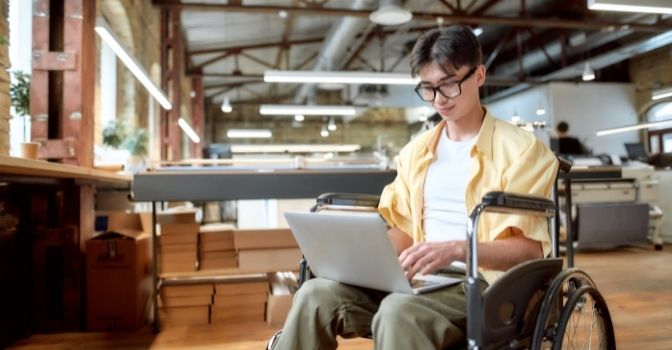Diversity and inclusion are fundamental pillars of a caring, strong and understanding society. In our communities, they foster connectivity, compassion and empathy. In our workplaces, they drive creativity, innovation and insight.
Studies show there are loads of benefits to businesses that employ people with a disability and being inclusive is even more important for organisations that serve people with a disability. Embracing accessibility creates a culture of understanding and awareness that enables you to better meet the needs of clients and ensures staff members with a disability are supported to excel.
As a co-founder of the Inclusive Employment Movement which Leap in! co-founded, we’ve heard from many businesses that they are uncertain how to make their businesses and workplaces more accessible. Read on for some tips from our free Inclusive Employment ebook.
Taking the first steps.
There’s a well-known quote that progress is impossible without change and that’s definitely the case when it comes to creating a more accessible business. Below, we’ve identified seven steps that create a pathway to action for your business.
- Commit to change and action at a leadership level
- Reach out to other organisations already on the journey
- Get your team involved
- Develop an Accessibility Action Plan that sets out the actions you will take and when you will take them
- Benchmark your organisation so you can track success
- Become a Disability Confident Recruiter
- Take action – small steps are better than none!
Read on for some tips or check out the Leap in! Inclusive Employment ebook for more details.
Access and signage.
Australian law says that customers with disabilities should be able to access your goods or services just like any other customer. So improving access will support both employees and customers as well as meet your legal responsibilities.[1]
Here are some of the things you can do to provide better access for everyone:
- Have clear markings on steps or pathways
- Install better lighting
- Provide ramp access or other level entry options
- Provide close, dedicated car parking spaces
- Install braille and tactile signage
- Make the entrance easy to see with clear signage in contrasting colours
- Avoid using advertising that could become a hazard such as A-frame signs on pathways.
Access to safety information may need to be supplied in different formats such as video, large fonts, audio or braille, particularly for employees.[2]
Evacuation considerations.
- Ensure your evacuation procedure is inclusive of people with a disability
- Develop a Personal Emergency Evacuation Plan (PEEP) for each person with a disability
- Consider a “buddy” system for any employees with disability that may need support to evacuate
- Ensure fire wardens know who requires additional assistance and understand the PEEP for each person
- Refer to the Australian Network on Disability guidelines for more information.
Moving around the workplace or business.
- Remove or relocate obstructions
- Keep access areas clear
- Set up office and retail spaces with plenty of room between desks, cubicles, aisles, displays etc
- Avoid using floor mats or coverings that could become trip hazards
- Install handrails if required
- Apply safety stickers to reflective glass
- Create wide doorways and entry areas
- Review other areas including board rooms and staff kitchens for potential improvements
- Ensure there are accessible toilets. These should be on the ground floor if the building does not have a lift.
Preparing your workplace.
It is important to remember that people with a disability are not an homogeneous group so there is no one size fits all approach to preparing a workplace for employees with diverse abilities.
For each disability type, specific requirements may need to be considered to maximise the productivity of each individual.[3]
- People with mobility impairments may need additional attention to accessibility and the physical layout of the workplace
- People with intellectual disabilities might need individual job tasks to be broken down into clear steps
- People who are deaf may require coworkers to use alternative communication methods
- People with psychosocial disabilities may require more frequent breaks.[4]
Consult with the employee to find out what workplace customisation, adjustments or supports they need.
If Disability Employment Services (DES) has been involved in the hire process, the DES representative can advocate on behalf of the person and discuss any workplace needs during the recruitment phase. Funding is also available for additional training and workplace modifications.
Get your free inclusive employment ebook.
Leap in! has developed a free ebook to support businesses to create a culture of inclusion for people with diverse abilities. The ebook contains detailed information about creating an Accessibility Action Plan, preparing your workplace and some of the funding supports that may be available. Download the ebook now and feel free to share it with your colleagues
Want more resources to help your clients?
Take a look at the news section on our updated website for more great stories, NDIS updates and more. We also have a range of ebooks, checklists and other valuable resources.
If you’d like to join our Provider Network, get in touch with our Provider Relations Team on 1300 05 78 74, or email partners@leapin.com.au to find out more.
Further reading
Global trends for diversity and inclusion in business.

